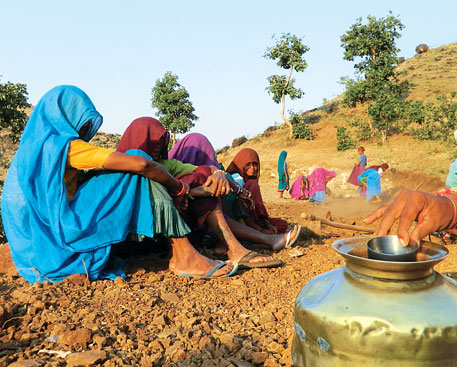Article and Image Courtesy : Down to Earth
Authors : Richard Mahapatra, M Suchitra and Moyna

People in Limbi village of Madhya Pradesh prefer laying roads. They are abandoning work on water structures because of wage delays
This is the little known big story of India’s nationwide rural employment programme. In the past five years the programme has sought to create tanks, ponds, wells and revive traditional water conservation structures at a scale and pace not witnessed before in the country. Millions of people in the countryside seeking jobs under the programme embarked on building or reviving 3.4 million water conservation structures, according to the Union rural development ministry. This is unprecedented given that before 2005, all the public wage schemes together created just about two million structures in six decades.
The programme, run under the Mahatma Gandhi National Rural Employment Guarantee Act (MGNREGA), assures 100 days of manual employment to any rural household that demands work. Under the Act, creation of water conservation structures is compulsory. As a result, today Indian villages have more per capita water structures than hospital beds, school teachers and policemen put together. Official data shows every village has six-seven such structures. Ask any old-timer in a village, this is more than enough to capture sufficient water for a village’s water security round the year.
More bounty awaits Indian villages this year. States have submitted proposals for 5.4 million more water conservation structures under the employment programme for this fiscal. If taken up, these proposals will more than double each village’s capacity to harvest water.
MGNREGA, credited for the ruling United Progressive Alliance’s (UPA’s) re-election in 2009, has emerged as the world’s largest public wage programme, with a budget that does not have a match in India’s past. In the past five years, the Central government spent close to Rs 110,000 crore on the programme or about Rs 45 lakh for every panchayat. Of this, the spending on water conservation structures was close to Rs 54,000 crore.
Arguably, these structures should have created a huge water harvesting capacity. The programme claims the added capacity is 3.07 billion cubic metres under water conservation and renovation of traditional water bodies, two of the four categories of water-related works under MGNREGA. This can take care of the drinking and cooking water needs of the country. Irrigation channels dug under the programme cover enough distance to make two return trips to the moon (see ‘Potential created’).